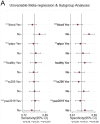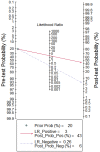Diagnostic value of circRNAs as effective biomarkers in human cardiovascular disease: an updated meta-analysis
- PMID: 35370465
- PMCID: PMC8964318
- DOI: 10.7150/ijms.67094
Diagnostic value of circRNAs as effective biomarkers in human cardiovascular disease: an updated meta-analysis
Abstract
Background: A growing body of literature has demonstrated that circular RNAs (circRNAs) are the potential biomarkers in human cardiovascular disease (CVD). Therefore, a meta-analysis based on current studies was accomplished to appraise the role of circRNAs in the diagnostic of CVD patients. Methods: Studies before October 30, 2021, were searched using PubMed, EMBASE, the Web of Science, and Cochrane Library. The diagnostic odds ratio (DOR) with a confidence interval (CI) of 95% was used to investigate the associations between circRNAs and CVDs. Results: A total of 27 eligible articles were selected, including 47 studies, with 6833 participants meeting the criteria standard constrain. The pooled overall sensitivity and specificity for circRNAs expression profile in differentiating CVD patients from controls (non-CVDs or healthy subjects) were 0.81 (95%CI 0.78-0.83) and 0.74 (95%CI 0.68-0.78), respectively; the overall positive likelihood ratio was 3.1 (95%CI 2.5-3.7); the negative likelihood ratio was 0.26 (95%CI 0.22-0.31); the overall diagnostic odds ratio corresponding to an area under the curve of 0.85 (95%CI 0.81-0.88) was 12 (95%CI 9-16). Subgroup analysis indicated that the serum rather than blood has higher diagnostic accuracy. Likewise, meta-regression analysis demonstrated that the specimen, detection method, sample size, and publication year were the main sources of heterogeneity. Sensitivity analysis and Deeks' funnel plot revealed that our results are relatively robust. Conclusions: Our evidence-based analysis results suggested that circRNAs provide higher diagnostic accuracy in the prediction of CVDs. Thus, circRNAs might be potential biomarkers in CVDs.
Keywords: biomarker; cardiovascular disease; circRNAs; diagnosis; meta-analysis.
© The author(s).
Conflict of interest statement
Competing Interests: The authors have declared that no competing interest exists.
Figures








Similar articles
-
Diagnostic value of circular RNAs in colorectal cancer: A systematic review and meta-analysis.Pathol Res Pract. 2019 Dec;215(12):152680. doi: 10.1016/j.prp.2019.152680. Epub 2019 Oct 3. Pathol Res Pract. 2019. PMID: 31635986
-
Long noncoding RNAs and circular RNAs as potential diagnostic biomarkers of inflammatory bowel diseases: a systematic review and meta-analysis.Front Immunol. 2024 Mar 8;15:1362437. doi: 10.3389/fimmu.2024.1362437. eCollection 2024. Front Immunol. 2024. PMID: 38524131 Free PMC article.
-
CircRNAs as promising biomarker in diagnosis of breast cancer: An updated meta-analysis.J Clin Lab Anal. 2021 Sep;35(9):e23934. doi: 10.1002/jcla.23934. Epub 2021 Jul 31. J Clin Lab Anal. 2021. PMID: 34331339 Free PMC article.
-
A novel strategy of identifying circRNA biomarkers in cardiovascular disease by meta-analysis.J Cell Physiol. 2019 Dec;234(12):21601-21612. doi: 10.1002/jcp.28817. Epub 2019 May 21. J Cell Physiol. 2019. PMID: 31115050 Review.
-
The predictive value of circular RNAs in the diagnosis, prognosis and clinicopathological features of thyroid cancer: A systematic review and meta-analysis.Pathol Res Pract. 2022 Aug;236:153871. doi: 10.1016/j.prp.2022.153871. Epub 2022 Apr 2. Pathol Res Pract. 2022. PMID: 35797852 Review.
Cited by
-
Bibliometric analysis of the research hotspots and trends of circular RNAs.Heliyon. 2024 May 17;10(10):e31478. doi: 10.1016/j.heliyon.2024.e31478. eCollection 2024 May 30. Heliyon. 2024. PMID: 38818139 Free PMC article. Review.
-
Potential biomarkers for retinopathy of prematurity identified by circular RNA profiling in peripheral blood mononuclear cells.Front Immunol. 2022 Aug 23;13:953812. doi: 10.3389/fimmu.2022.953812. eCollection 2022. Front Immunol. 2022. PMID: 36081509 Free PMC article.
References
-
- Mozaffarian D, Benjamin EJ, Go AS. et al. Executive Summary: Heart Disease and Stroke Statistics-2016 Update: A Report From the American Heart Association. Circulation. 2016;133(4):447–454. - PubMed
-
- Viereck J, Thum T. Circulating Noncoding RNAs as Biomarkers of Cardiovascular Disease and Injury. Circulation research. 2017;120(2):381–399. - PubMed
-
- Beermann J, Piccoli MT, Viereck J, Thum T. Non-coding RNAs in Development and Disease: Background, Mechanisms, and Therapeutic Approaches. Physiological reviews. 2016;96(4):1297–1325. - PubMed
Publication types
MeSH terms
Substances
LinkOut - more resources
Full Text Sources

